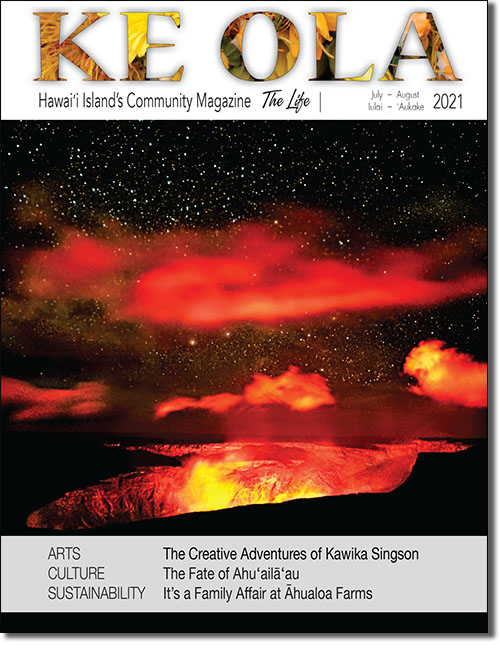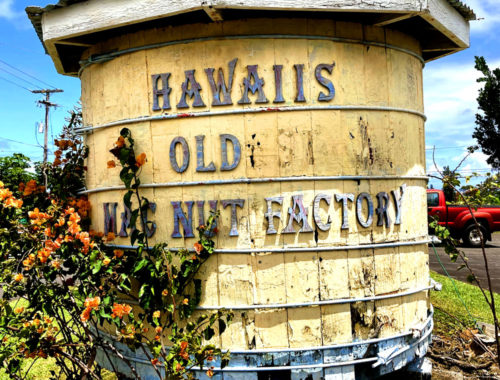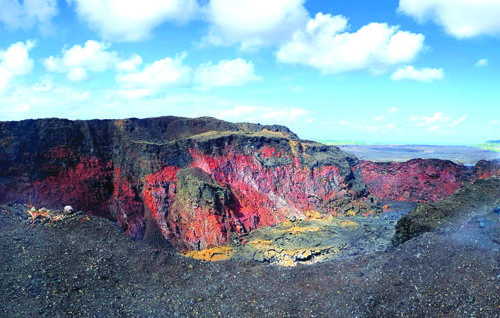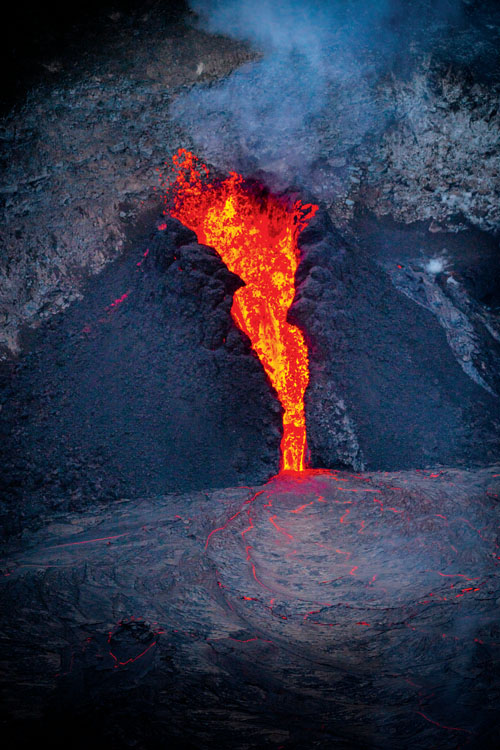
The Night Lava Returned to Halema‘uma‘u Crater
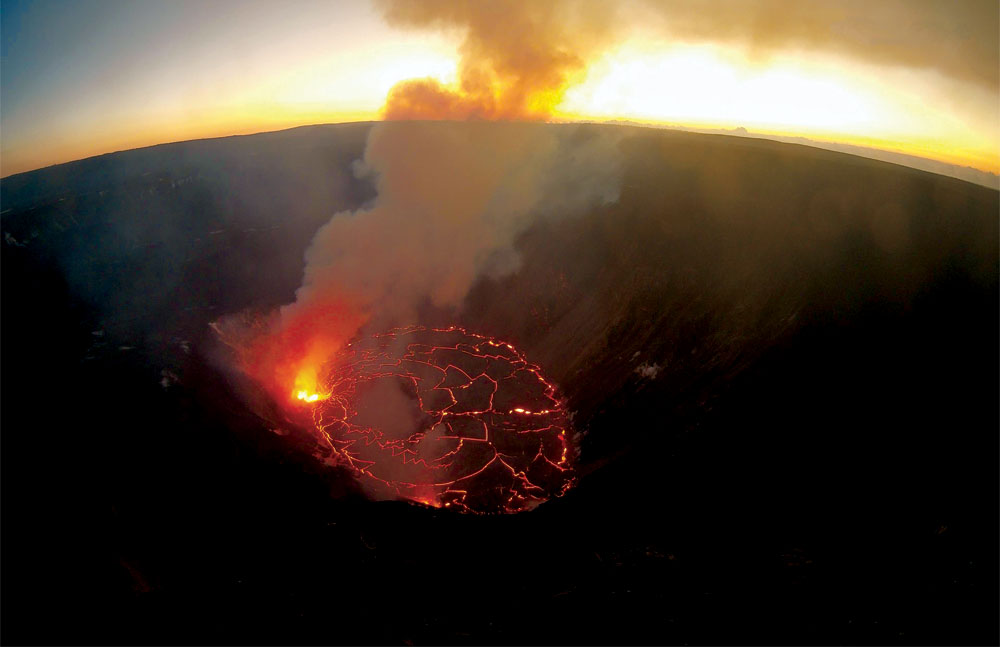
By Stefan Verbano
Bruce Miller and Ed Clapp headed to the crater overlook that fateful December night to stargaze and celebrate the solstice. A cold, wet mist hung in the mountain air, surrounding them. They approached the volcano’s rim as an evening breeze carried sheets of drizzle out past the cliffs and down into the great chasm of slumping rock cloaked in darkness below. Beams of light from the crescent moon mingled with the mist in the distance creating a moonbow, its faint white glow reflected one moment and obscured the next by ranks of translucent clouds rolling past.
The night was quiet and still at first. Bruce and Ed looked in all directions and saw only the cold darkness of a deserted overlook and parking lot. Stout ‘ōhi‘a trees stood silhouetted against a sky of intermittent stars. The formless black void of Halema‘uma‘u Crater lay beyond, swallowing up all of the falling moonbeams attempting to illuminate its elaborate, craggy pit and muddy lake. Ever since its dramatic expansion in 2018, this stepped canyon has filled the horizon at Kīlauea Volcanoʻs summit from end to end.
Suddenly, with no warning—not even the slightest rumble felt—a tiny tinkle of light began to flicker somewhere deep within the craterʻs all-engulfing black hole. Ed noticed it first, and pointed it out to Bruce. It was just before 9:30pm. “He looked out and said: ‘Thereʻs a light down there,’” Bruce said, recalling the sequence of events that night. “I said: ‘Come on!’”
The two men stood at the rim for a minute arguing about what could possibly be causing this flickering so far out there in the void…a geologist’s headlamp? A camera? A drone? They considered every other possible explanation besides the one creeping around at the back of their minds. Neither one at first wanted to entertain the idea that a year and a half after the formation of Halema‘uma‘u’s peaceful and unassuming gravel lake in July 2019, somehow, somewhere out there in the cold, misty abyss, the brilliant reddish-orange lava that is the lifeblood of Hawai‘i Island—that rained down such utter destruction onto its Lower Puna District nearly three years ago—had found its way back to the surface once again. Ten minutes later they knew it couldn’t be anything else; Kīlauea was erupting.
Timing Is Everything
Streams of lava broke through the crater walls in multiple places the night of December 20, 2020—Winter Solstice Eve— sending molten rock cascading down into the lake of chai tea-colored water, causing it to boil off and send a massive white, puffy mushroom cloud of steam high into the sky. It mixed with black smoke from the emerging fissures turning it grey, and the streams flowed faster and faster, roiling the orange water below, making it hiss and gurgle and thrash about wildly. Having overcome nagging disbelief, Bruce and Ed now had the first few pangs of fear and panic cropping up in their chests.
“There was white steam and black smoke turning in on itself, not rising straight up, but rising and falling,” Ed says. “It was really beautiful to watch. And you’re watching this, awestruck, and then you’re wondering: are we going to die tonight? Is there going to be some big explosion?”

They considered retreating, but decided to risk it and stay. They watched as the lava glow grew in intensity and the crater’s walls lit up at one end, illuminating in great detail the many intricate ridges and crevices that make up the towering cliffs, casting them in a dramatic red relief. Within half an hour of that first tinkling of light, the fissures were pumping out fountains of lava that spread their eerie glow onto the grey plume and the low-hanging clouds. The night’s darkness was lifting, and everything around the deserted overlook was turning scarlet.
Not knowing who else to call, Bruce dialed 911. The dispatcher on the other end put him through to the National Park Service. “I’m up here at Kīlauea caldera…it’s erupting,” Bruce told them.
They asked him to take a photo of what he was seeing with his smartphone and text it to them. Not long after he hung up, the first people arrived at the scene besides Bruce and Ed. It was Kathleen and Donald Mulliken, longtime residents of Volcano Village. Kathleen remembers, “It was very exciting even though we’ve seen the eruption so many times in the past. Her coming to life like that with the beautiful billowing clouds was breathtaking.” By 10:30pm, roughly an hour after Ed initially noticed the light in the crater and the dark stillness of the night was broken forever, the eruption had become “huge,” according to Bruce.
“It was really, really bright,” Bruce says. “It was beautiful…the plume was going up like a mushroom and kind of spilling over, like it was an avalanche or something. It was pretty damn impressive.”
As the night sky grew redder and the lava fountains within the crater grew taller, the sheer power of the unfolding spectacle dissolved any lingering fear in the two friends and replaced it with wild wonder and primal awe. One of the largest fissures would grow that night to emit lava fountains more than 160 feet high.
“I was excited about it. I was thinking: this is great,” Bruce says. “Because it’s part of what makes this place so special—to be able to see that. To see the raw earth flowing, for me, it’s magical, it’s incredible. I would watch it every night if I could.”
By the time Bruce and Ed finally left Kīlauea’s summit and headed back down the mountain to their homes in the town of Volcano, the park was swarming with activity. The overlook spots around the crater rim were crowded with onlookers. Parking lots were filling up. A long line of cars full of curious passengers hoping to catch a glimpse of the lava geysers and radiant red clouds backed up from the park’s entrance gate out onto the highway. Word of the eruption seemed to spread and grow as quickly as the lava fountains themselves.
“I think people were calling their friends, telling them: get over here!” Bruce says.
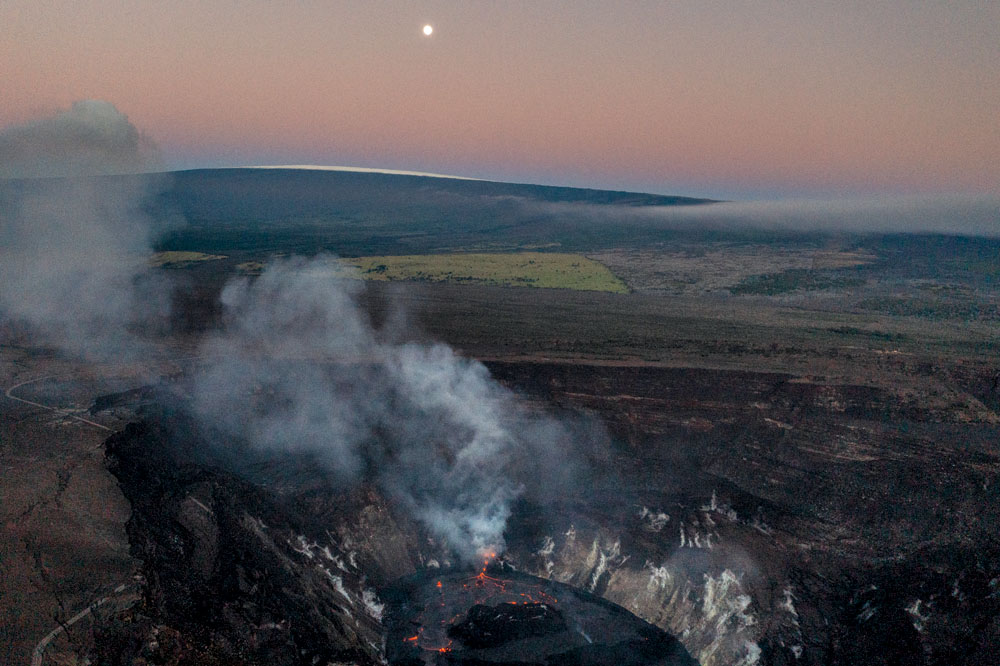
Geology, History and Technology
Jim Kauahikaua is a geophysicist at the Hawaiian Volcano Observatory (HVO) run by the US Geological Survey, and previously served as its scientist-in-charge. His expertise in the field and his thorough understanding of Kīlauea’s geological past helps put the eruption that began that cold December night into context.
“The volcano’s summit has been very active over the past two centuries,” Jim explains, “exhibiting cycles of eruption where lava levels rise gradually and then drop and disappear for a short time, before re-emerging and rising again.” Sometimes these cycles produce eruptions in the East Rift Zone, like those in 1840, 1955, and 1959 through 1960. The eruption that began in 1983 continued for 35 years, stopping on April 30, 2018, with the onset of the massive 2018 Lower Puna Eruption three days later.
Interviewed in April 2021, Jim said the return of lava to Halema‘uma‘u four months prior didn’t overly concern him, in regards to a possible repeat of 2018, because—at least at the time—there simply hadn’t been enough lava produced yet. “Usually the rise [part of the cycle] reaches elevations that are much higher than the current lava lake before rift zone action is initiated,” Jim says.
Still, HVO staff are vigilant in their monitoring of this new eruption, relying on advanced scientific instruments and technologies to study its progress, collect valuable geologic data for a better understanding of volcanoes, and help inform and warn the public about the range of hazards that come with living on a volcanic island.
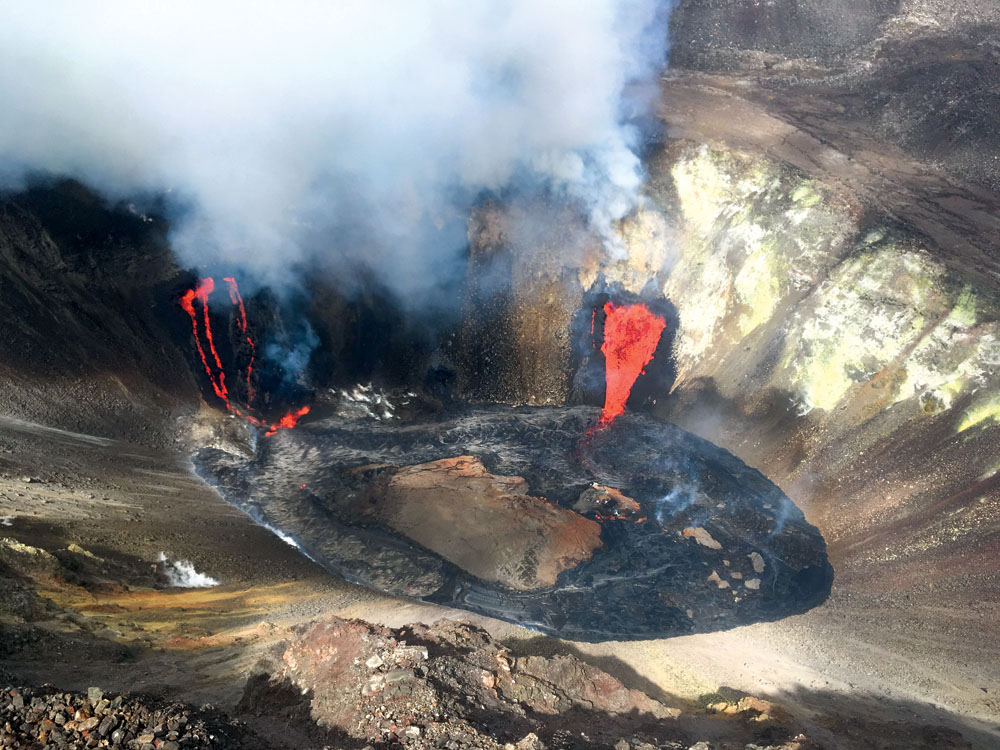
HVO’s monitoring networks include seismometers for detecting earthquakes, GPS systems so acute they can measure ground movements on the scale of centimeters, tiltmeters, gas sensors, satellite radar, time-lapse cameras, live webcams, and more. Poring over this data, HVO staff continually watch for changes on multiple fronts from the patterns of earthquakes to the rate of ground tilt to the emission level and chemical composition of volcanic gasses.
HVO then condenses all of this information into routine public updates; daily for Kīlauea, weekly for Mauna Loa, and monthly for Hawai‘i’s other volcanoes not currently showing signs of activity: Mauna Kea, Hualālai, Lō‘ihi, and Haleakalā. The observatory even runs a Volcano Notification Service available to anyone, which sends out automated email alerts about volcanic activity in the state.
Kīlauea’s new eruption raged into the new year, churning out millions of cubic yards of lava and thousands of metric tons of sulfur dioxide per day at its peak. By mid-April 2021, it had calmed significantly from the terrifying and mesmerizing spectacle Bruce and Ed saw that night when they just happened to be in the right place at the right time. The lava lake within Halema‘uma‘u grew to be more than 750 feet deep, and its interminable smoking could be seen from the overlook on a sunny day as the breeze carried it across the greatly expanded chasm. After spending a year and a half as a lackluster gravel pit filled with muddy water and looking extinct, the volcano’s swirling lava cauldron—Hawai‘i Island’s hallmark that once drew more than two million people a year to see its smoldering pit and deep red glow—had come roaring back to life again, continuing the eternal cycle and restoring the crater to its former glory, if only for a short while. Just as the eruption was celebrating its five-month anniversary, lava pouring through the vents dwindled and stopped, and the lake finally crusted over. Last surface activity was seen on May 23, 2021, after which HVO scientists deemed the eruption to be “paused.” ❖
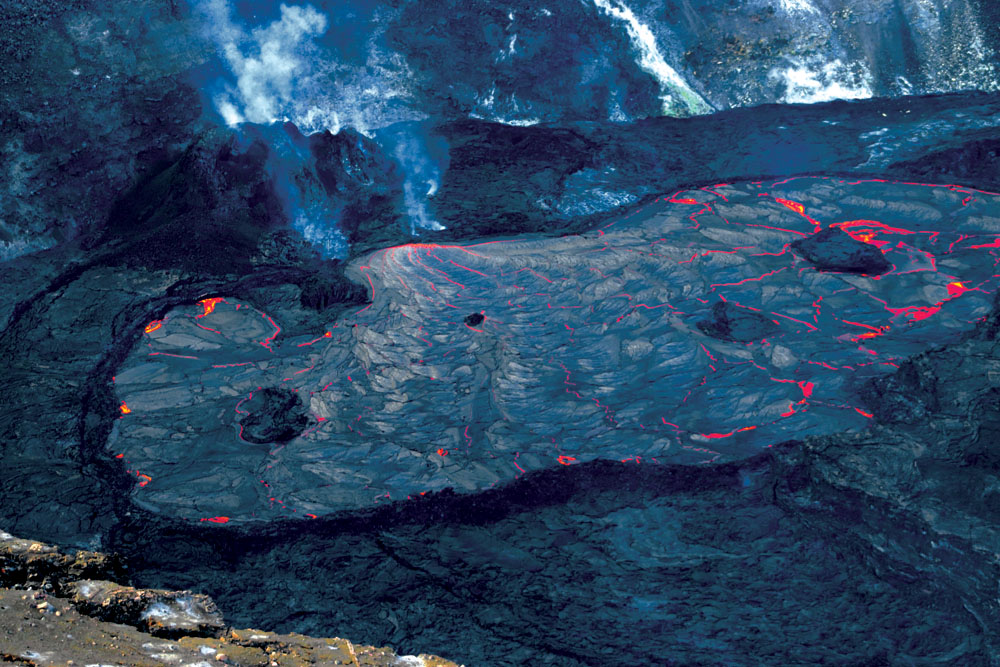
For more information:
usgs.gov/observatories/hawaiian-volcano-observatory
nps.gov/havo/learn/news/20201221_nr_new-summit-eruption-kilauea.htm
volcanoes.usgs.gov/vns2/
